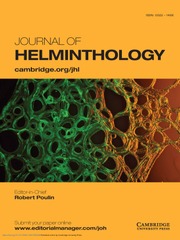No CrossRef data available.
Article contents
Genetic variation and population structure of Haemonchus contortus: an in-silico analysis
Published online by Cambridge University Press: 15 July 2025
Abstract
Haemonchus contortus is a parasitic nematode that causes significant economic losses in ruminant livestock worldwide. In this study, we assessed the global genetic diversity and population structure of H. contortus using mitochondrial COX1 and ribosomal ITS2 sequences retrieved from the NCBI GenBank database. In total, 324 haplotypes of the COX1 and 72 haplotypes of the ITS2 were identified. The haplotype diversity values were all higher than 0.5, and the nucleotide diversity values were higher than 0.005. The Tajima’s D value for COX1 (−1.65634) was higher than that for ITS2 (−2.60400). Fu’s Fs, Fu and Li’s D (FLD), and Fu and Li’s F (FLF) values also showed high negative values, indicating a high probability of future population growth. In addition, the high fixation index (FST) value suggests significant genetic differentiation among populations. The haplotype networks of H. contortus populations based on COX1 sequences revealed clear geographic clustering, whereas ITS2 sequences showed more haplotype admixture across regions. The results of phylogenetic analyses were consistent with the haplotype networks. These findings highlighted that H. contortus populations exhibit significant genetic variation and are undergoing rapid population expansion, with clear genetic differences across geographic regions. This study established critical baseline data for future molecular epidemiology studies, which could guide region-specific parasite surveillance and targeted control strategies, thus helping to mitigate the risk of cross-border parasite transmission and drug resistance.
Information
- Type
- Research Paper
- Information
- Copyright
- © The Author(s), 2025. Published by Cambridge University Press

